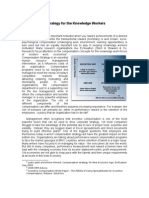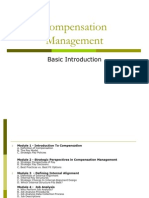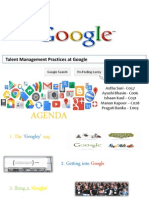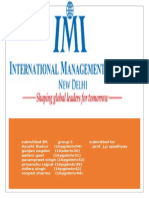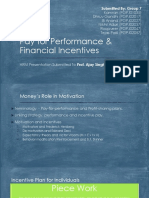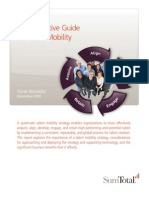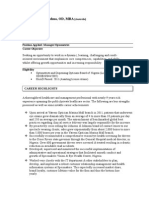Maruti HR Scorecard
Maruti HR Scorecard
Uploaded by
Karan ChandelCopyright:
Available Formats
Maruti HR Scorecard
Maruti HR Scorecard
Uploaded by
Karan ChandelOriginal Description:
Copyright
Available Formats
Share this document
Did you find this document useful?
Is this content inappropriate?
Copyright:
Available Formats
Maruti HR Scorecard
Maruti HR Scorecard
Uploaded by
Karan ChandelCopyright:
Available Formats
About Maruti
as Maruti Udyog Limited, is an automobile manufacturer in India.[8] It is a subsidiary of Japanese
automobile and motorcycle manufacturer Suzuki.[7] As of November 2012, it had a market share of
37% of the Indian passenger car markets.[9] Maruti Suzuki manufactures and sells a complete range
of cars from the entry level Maruti 800, Alto, to the hatchback Ritz, Celerio, Ciaz, A-Star, Swift,
Wagon R, Zen and sedans DZire, Kizashi and SX4, in the 'C' segment Eeco, Omni, Multi Purpose
vehicle Suzuki Ertiga and Sports Utility vehicle Grand Vitara.[10]
The company's headquarters are at No 1, Nelson Mandela Road, New Delhi.[2] In February 2012, the
company sold its ten millionth vehicle in India.
They will us the 7 step approach to create a HR Scorecard for Maruti.
1.
2.
3.
4.
5.
6.
7.
Define the business strategy
Outline company value chain
Outline a Strategy Map
Identify HR Deliverables
Align HR strategy to Business strategy
Design Strategy Measurement System
Execute Management by measurement
Business Strategy of Maruti
This involves learning more b
h
g
g bj v
g
. Th HR
Department should be in a position to align its objectives and goals with those of the organization.
To do this the HR staff must get to know the management team and their challenges, conduct audits
to determine if employees have the competencies and skills necessary to help the company achieve
its Mission, Vision, and Strategic Objectives.
With the passenger car sales declining over the past two months over spiralling fuel prices and high
int
g
g
p
marketing strategy to increase its sales among the first time buyers, a company official said.
The company has started campaign for targeted customers. They are looking at a specific customer
base like orange in Nagpur, jute mill owners or mango groTheyrs in Bengal. They are also working to
increase our sales in rural areas.
The growth this fiscal year will be in single digit. In the beginning of the year, a 12-15 per cent
growth was predicted for the industry. So far, the passenger car industry has grown about four per
cent. They expect sales will pick up in the coming festive season, but still it will be in the single digit
However, the company will go ahead with its capacity expansion plan. The capacity expansion will go
on as it is part of our long term plans. The industry size is expected to be about 4.2 million by 2015.
They will have a total annual capacity of 1.7 million units by the time which will help up us to
maintain the present market share of 44 per cent.
Strategy Map and HR Deliverables
Designing the Scorecard
When business owners and managers formulate business plans and strategies, they often leave out
an important component of these plans. Human resources staff are often not consulted nor invited
to participate in the planning process. When marketing, sales, manufacturing or finance are asked to
implement their strategies and tactics for the coming year, they may find themselves short-handed,
or worse, with people with the wrong aptitudes. Aligning HR with business strategies makes sense
and helps ensure the company can realize goals.
n performance-driven organizations, performance metrics are often used to express the value and
success each department contributes. The efforts of human resources can't be expressed as a direct,
bottom-line number contributing to sales, although the value of effective HR practices may make
significant contributions toward a company's success. An HR scorecard measurement system allows
a business to tangibly monitor HR performance.
Assessing the Corporate Culture
Before designing a scorecard, the HR professional should understand top-level management goals
and strategies for the enterprise. A manufacturing business in an industry with much competition
may need low-cost labor to meet necessary margins, while a cutting-edge tech startup seeks
innovative programmers, regardless of cost. How a company utilizes its workforce plays a role in
how HR performance can be assessed. A particular business or industry may have its own priorities
for HR assessment. A factory, for example, may focus on safety initiatives, while a call center
watches turnover.
Operational or Outcome: The Scorecard Focus
A business that applies metrics to elements of production often works in measures of efficiency,
such as orders per hour or waste per 100 units. A simple implementation of metrics on a personnel
level would simply transfer these operational measures from department to worker. While a natural
extension of metrics practices, these have little value in assessing HR function. An HR scorecard is
often better expressed in terms of outcome, and this may require a long-term, broad-picture
approach. For example, if an HR objective is to grow a stable workforce with improved productivity,
orders per hour performance is still valid, but across an entire department, and over a defined
period of time. That information combines with turnover statistics for the same period to establish a
scorecard metric.
Compiling The Metrics
Referring to the strategic objectives of the company and matching these with outcome-based HR
goals provides the basis for the HR scorecard. SMART methodology provides an outline for each
scorecard item to be specific, measurable, achievable, relevant and time constrained. For example,
using the SMART acronym might develop a scorecard objective of "increased training" into "Health
and safety training hours increased to 10 hours or more per employee over the next two quarters."
Implementing the HR Scorecard
While implementation typically comes after the design of the HR scorecard, considering how the
scorecard is used in practice may help focus the design. The HR scorecard may represent change to
many and may be resisted simply for this fact. Whenever scorecard items can be supported with
existing data, potential resistance could be eliminated. Assigning champions, either to the entire
scorecard or to one or more of its items, will also improve chances for success.
You might also like
- Case Studies - Strategic StyleDocument9 pagesCase Studies - Strategic StyleAyush Bankar0% (1)
- Talent-Factsheet Cipd Nov 21Document8 pagesTalent-Factsheet Cipd Nov 21Klayton MonteverdeNo ratings yet
- Boss Exotics Final PresentationDocument15 pagesBoss Exotics Final Presentationapi-652767745No ratings yet
- E-Book Building HR Function For Your StartupDocument42 pagesE-Book Building HR Function For Your StartupAndoko VenturaNo ratings yet
- Succession Planning Proposal To Ca Consultants LTDDocument12 pagesSuccession Planning Proposal To Ca Consultants LTDomoyegunNo ratings yet
- HR Challenges in The Indian Oil and Gas SectorDocument4 pagesHR Challenges in The Indian Oil and Gas SectoraiswaryaNo ratings yet
- Employee Value Proposition EVP: Workforce PlanningDocument2 pagesEmployee Value Proposition EVP: Workforce PlanningKevin McleanNo ratings yet
- Employee BenefitsDocument4 pagesEmployee Benefitsleo143No ratings yet
- Research QuestionDocument4 pagesResearch QuestionNirdesh Dev ShresthaNo ratings yet
- VP Director Supply Chain Logistics in United States Resume David StonichDocument2 pagesVP Director Supply Chain Logistics in United States Resume David StonichDavid StonichNo ratings yet
- Unit 4 Expatriate CompensationDocument36 pagesUnit 4 Expatriate Compensationlizza samNo ratings yet
- HR Challenges in RecruitmentDocument3 pagesHR Challenges in Recruitmentlovish0595No ratings yet
- Microsoft HR Practices-SibzDocument21 pagesMicrosoft HR Practices-SibzPradeep Kumar Singh0% (3)
- MercerDocument20 pagesMercerdrbunheadNo ratings yet
- The Labour Market Demand and SupplyDocument29 pagesThe Labour Market Demand and SupplyNafis SiddiquiNo ratings yet
- Reward ManagementDocument5 pagesReward ManagementmariabuttNo ratings yet
- Job Rotation AssignmentDocument7 pagesJob Rotation AssignmentRohit MathurNo ratings yet
- Integrity Managment and Cultural Due DiligenceDocument46 pagesIntegrity Managment and Cultural Due Diligencestars_70000No ratings yet
- Downsizing HRDocument12 pagesDownsizing HRBinay Kumar ChoudharyNo ratings yet
- Best Presentation On InfosysDocument23 pagesBest Presentation On InfosysSachin MethreeNo ratings yet
- The Future of HR - Preliminary ResultsDocument31 pagesThe Future of HR - Preliminary Resultsgabik1gNo ratings yet
- Global Compensation, Benefits & TaxesDocument34 pagesGlobal Compensation, Benefits & TaxesSunny Deo Bhakta100% (1)
- HR Leaders in Manufacturing FirmDocument8 pagesHR Leaders in Manufacturing FirmPraveen ChandrasekarNo ratings yet
- Variable Pay ReportDocument8 pagesVariable Pay ReportRahul Dogra100% (1)
- Kavit Sharma: Academic QualificationsDocument2 pagesKavit Sharma: Academic QualificationsKavit SharmaNo ratings yet
- Human Resource Management Practice in Microsoft CorporationDocument6 pagesHuman Resource Management Practice in Microsoft CorporationMahak SharmaNo ratings yet
- HR ProjectDocument55 pagesHR ProjectRakshit BhardwajNo ratings yet
- Compensation Strategy For The Knowledge WorkersDocument5 pagesCompensation Strategy For The Knowledge WorkersKK SharmaNo ratings yet
- New HRCS 8 Competency Model Focuses On Simplifying ComplexityDocument3 pagesNew HRCS 8 Competency Model Focuses On Simplifying ComplexityBNo ratings yet
- Compensation StructureDocument57 pagesCompensation Structuresagarthegame100% (1)
- Future of Recruiting Report by LinkedinDocument65 pagesFuture of Recruiting Report by LinkedinNikolasNo ratings yet
- Retention of Talent & Employee MotivationDocument4 pagesRetention of Talent & Employee MotivationHarshal TakNo ratings yet
- SHRM Article-Total Rewards StrategyDocument3 pagesSHRM Article-Total Rewards StrategyAshwindudeNo ratings yet
- PWC Performance Survey 2015Document28 pagesPWC Performance Survey 2015Khushbu SinghNo ratings yet
- Car Policy: Salient FeaturesDocument2 pagesCar Policy: Salient FeaturesZahid Shaikh100% (1)
- Talent Management FinalDocument23 pagesTalent Management FinalManan Kapoor75% (4)
- Reward Management22Document19 pagesReward Management22Denisho DeeNo ratings yet
- Learning and DevelopmentDocument30 pagesLearning and DevelopmentpriyanshuNo ratings yet
- Change in Role of HR Due To Recession - PaperDocument27 pagesChange in Role of HR Due To Recession - PaperSidharth KapilNo ratings yet
- Aon 2018 Trends in Global Employee EngagementDocument19 pagesAon 2018 Trends in Global Employee EngagementRajendra LamsalNo ratings yet
- Group 7-Pay For Performance & Financial IncentivesDocument9 pagesGroup 7-Pay For Performance & Financial IncentivesAnandNo ratings yet
- A Roadmap For Aligning HR Strategy To Organizational Imperatives - HR Human ResourcesDocument3 pagesA Roadmap For Aligning HR Strategy To Organizational Imperatives - HR Human ResourceskumarsambasivanNo ratings yet
- A Study in The Typical Functions of A Typical HR Department in An Typically Advanced OrganizationDocument30 pagesA Study in The Typical Functions of A Typical HR Department in An Typically Advanced OrganizationansmanstudiesgmailcoNo ratings yet
- Perf App Model 2 - For ManagersDocument8 pagesPerf App Model 2 - For ManagersVamsi Krishna NukarajuNo ratings yet
- Designing A Pay Structure - Im - 9.08Document47 pagesDesigning A Pay Structure - Im - 9.08Fazle Rabby100% (1)
- Cipd Assignment Submission Declaration Candidate DeclarationDocument6 pagesCipd Assignment Submission Declaration Candidate DeclarationhayaNo ratings yet
- 2016 PWC Q1 HR QuarterlyDocument14 pages2016 PWC Q1 HR QuarterlyDebbie CollettNo ratings yet
- Succession Planning ToolkitDocument8 pagesSuccession Planning ToolkitMonjurul AlamNo ratings yet
- Six Principles of Effective Global Talent ManagementDocument39 pagesSix Principles of Effective Global Talent ManagementYMA StudioNo ratings yet
- HumanResourcesPolicy NESTLEDocument9 pagesHumanResourcesPolicy NESTLEROhit NagPalNo ratings yet
- Aon Hewitt TRQ V1I3Document28 pagesAon Hewitt TRQ V1I3shallaadityaNo ratings yet
- WhitePaper PDFDocument18 pagesWhitePaper PDFGaurav GopalNo ratings yet
- Talent EngagementDocument11 pagesTalent EngagementSandhya RajNo ratings yet
- The Ethical Nature of HRMDocument9 pagesThe Ethical Nature of HRMVishal Kant Rai100% (1)
- The Definitive Guide To Talent MobilityDocument12 pagesThe Definitive Guide To Talent MobilitySumTotal Talent ManagementNo ratings yet
- ADP Report 20 Feb 2024Document44 pagesADP Report 20 Feb 2024sreewealthNo ratings yet
- HR GSR ManagementDocument53 pagesHR GSR Managementsumanth_0678100% (1)
- Accenture Trends Reshaping HR Workforce OneDocument12 pagesAccenture Trends Reshaping HR Workforce OnenafizNo ratings yet
- Bench StrengthDocument8 pagesBench StrengthFatima IqbalNo ratings yet
- Sid Employee EngagementDocument69 pagesSid Employee EngagementAkil DhilawalaNo ratings yet
- Final Presentation On Corporate Restructuring (GPIT & Accenture Bangladesh)Document10 pagesFinal Presentation On Corporate Restructuring (GPIT & Accenture Bangladesh)Sayma KhandakarNo ratings yet
- Chro JDDocument25 pagesChro JDsjlohithNo ratings yet
- Recruitment Process Outsourcing A Complete Guide - 2020 EditionFrom EverandRecruitment Process Outsourcing A Complete Guide - 2020 EditionNo ratings yet
- Case Study - Airtel RepositioningDocument7 pagesCase Study - Airtel RepositioningKrishan TiwariNo ratings yet
- GRP 4 MicroeconDocument40 pagesGRP 4 MicroeconVan DyneNo ratings yet
- Sharukh R Kapadia CVDocument3 pagesSharukh R Kapadia CVsharukh kapadiaNo ratings yet
- Kabel Eterna - Google SearchDocument1 pageKabel Eterna - Google SearchtwulandNo ratings yet
- Sal Institute of Management: Semester: 4 Product and Brand Management PLC Cycle On MaggiDocument4 pagesSal Institute of Management: Semester: 4 Product and Brand Management PLC Cycle On Maggidhaval2410No ratings yet
- Case Study (Group)Document15 pagesCase Study (Group)Mohammad Nazmin Syamsul BahriNo ratings yet
- Mergers and Acquisitions - Colgate Takes Over Toms of MaineDocument11 pagesMergers and Acquisitions - Colgate Takes Over Toms of MaineBhooshan ParikhNo ratings yet
- SM Unit - IIIDocument10 pagesSM Unit - IIIrammohan33No ratings yet
- Sample Professional CV.Document8 pagesSample Professional CV.HussanAliNo ratings yet
- Ashleigh Antonie Jeffers PREMIER INNDocument15 pagesAshleigh Antonie Jeffers PREMIER INNmustak.ahamed.duNo ratings yet
- NEW How To Sell More Shirts First 3 Chapters PDFDocument18 pagesNEW How To Sell More Shirts First 3 Chapters PDFJun Dela Cruz100% (2)
- DeclarationDocument6 pagesDeclarationRichard Mwenda RingeraNo ratings yet
- Final DestinationDocument265 pagesFinal DestinationIrine A. PedregosaNo ratings yet
- Syllabus IIDocument5 pagesSyllabus IIfelixsssNo ratings yet
- Advertisement Assignment SheetDocument2 pagesAdvertisement Assignment Sheetapi-353478397No ratings yet
- The Impact of Digitalization On Business CommunicatinDocument7 pagesThe Impact of Digitalization On Business CommunicatinIrina SaitanNo ratings yet
- Corporate PresentationDocument32 pagesCorporate Presentationanand1kumar-31No ratings yet
- IM (Amul) 2017Document17 pagesIM (Amul) 2017Khalid Sayed100% (1)
- Case Study - Tata Capital PDFDocument1 pageCase Study - Tata Capital PDFHaley HopperNo ratings yet
- Surat Dukungantender Safekick Limited Dengan PT Andalas Petroleum ServicesDocument9 pagesSurat Dukungantender Safekick Limited Dengan PT Andalas Petroleum Servicesyono DaryonoNo ratings yet
- Sugar IndustryDocument86 pagesSugar IndustryGowtham Polamarasetty71% (7)
- Brand Management Case Study ONDocument9 pagesBrand Management Case Study ONSabshNo ratings yet
- Literature Review of CRMDocument5 pagesLiterature Review of CRMJoney DeepNo ratings yet
- CDA ResumewithFolioDocument25 pagesCDA ResumewithFoliocdabandoNo ratings yet
- PresentationDocument18 pagesPresentationShravan GuptaNo ratings yet
- Less0N 1: Introduction To Quality Service Manangement in Tourism and HospitalityDocument7 pagesLess0N 1: Introduction To Quality Service Manangement in Tourism and HospitalityJoshua GuerreroNo ratings yet
- Coca-Cola HorizontalDocument49 pagesCoca-Cola HorizontalShahnawaz Aadil0% (1)



























